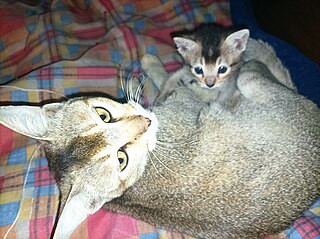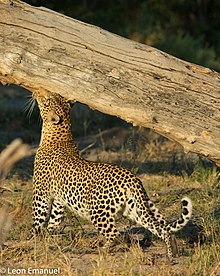
The vomeronasal organ (VNO), or Jacobson's organ, is the paired auxiliary olfactory (smell) sense organ located in the soft tissue of the nasal septum, in the nasal cavity just above the roof of the mouth in various tetrapods. The name is derived from the fact that it lies adjacent to the unpaired vomer bone in the nasal septum. It is present and functional in all snakes and lizards, and in many mammals, including cats, dogs, cattle, pigs, and some primates. Some humans may have physical remnants of a VNO, but it is vestigial and non-functional.

Weaning is the process of gradually introducing an infant human or another mammal to what will be its adult diet while withdrawing the supply of its mother's milk.

The flehmen response, also called the flehmen position, flehmen reaction, flehmen grimace, flehming, or flehmening, is a behavior in which an animal curls back its upper lip exposing its front teeth, inhales with the nostrils usually closed, and then often holds this position for several seconds. It may be performed over a sight or substance of particular interest to the animal, or may be performed with the neck stretched and the head held high in the air.

Animal communication is the transfer of information from one or a group of animals to one or more other animals that affects the current or future behavior of the receivers. Information may be sent intentionally, as in a courtship display, or unintentionally, as in the transfer of scent from predator to prey with kairomones. Information may be transferred to an "audience" of several receivers. Animal communication is a rapidly growing area of study in disciplines including animal behavior, sociology, neurology and animal cognition. Many aspects of animal behavior, such as symbolic name use, emotional expression, learning and sexual behavior, are being understood in new ways.
In ethology, territory is the sociographical area that an animal consistently defends against conspecific competition using agonistic behaviors or real physical aggression. Animals that actively defend territories in this way are referred to as being territorial or displaying territorialism.

The African buffalo is a large sub-Saharan African bovine. There are five subspecies that are recognized as being valid. Syncerus caffer caffer, the Cape buffalo, is the nominotypical subspecies, and the largest one, found in Southern and East Africa. S. c. nanus is the smallest subspecies, common in forest areas of Central and West Africa, while S. c. brachyceros is in West Africa and S. c. aequinoctialis is in the savannas of East Africa. The adult African buffalo's horns are its characteristic feature: they have fused bases, forming a continuous bone shield across the top of the head referred to as a "boss".

Dairy cattle are cattle bred for the ability to produce large quantities of milk, from which dairy products are made. Dairy cattle generally are of the species Bos taurus.

Scent gland are exocrine glands found in most mammals. They produce semi-viscous secretions which contain pheromones and other semiochemical compounds. These odor-messengers indicate information such as status, territorial marking, mood, and sexual behaviour. The odor may be subliminal—not consciously detectable. Though it is not their primary function, the salivary glands may also function as scent glands in some animals.

Behavioral enrichment is an animal husbandry principle that seeks to enhance the quality of captive animal care by identifying and providing the environmental stimuli necessary for optimal psychological and physiological well-being. Enrichment can either be active or passive, depending on whether it requires direct contact between the animal and the enrichment. A variety of enrichment techniques are used to create desired outcomes similar to an animal's individual and species' history. Each of the techniques used is intended to stimulate the animal's senses similarly to how they would be activated in the wild. Provided enrichment may be seen in the form of auditory, olfactory, habitat factors, food, research projects, training, and objects.

Cats need to communicate for a variety of reasons, including to show happiness, to express anger, to solicit attention, and to observe potential prey; cats collaborate, play, and share resources with each other. When they communicate with humans, they do so to get what they need or want, such as food, water, attention, or play.

Cat behavior is a cat's behavior and responses to events and other stimuli. Cat behavior includes body language, elimination habits, aggression, play, communication, hunting, grooming, urine marking, and face rubbing. It varies among individuals, colonies, and breeds.
A cat pheromone is a chemical molecule, or compound, that is used by cats and other felids for communication. These pheromones are produced and detected specifically by the body systems of cats and evoke certain behavioural responses.

Cattle are large, domesticated, bovid ungulates widely kept as livestock. They are prominent modern members of the subfamily Bovinae and the most widespread species of the genus Bos. Mature female cattle are called cows and mature male cattle are bulls. Young female cattle (heifers), young male cattle, and castrated male cattle (steers) are all colloquially called "cows".
Imprinting is most often used to describe an early-life bond that can later affect an animal's mate choice. More broadly, the term refers to a rapid and selective learning process that only can occur during certain times in an animal's life. In sheep, ewes having just given birth imprint onto their lambs on the basis of olfactory cues, allowing mothers to distinguish their own offspring from other lambs in the flock. This olfactory-based imprinting is dependent on a ewe's behavior after giving birth, on the presence of amniotic fluid, and on a specialized odor-influenced learning process which allows the ewe to quickly memorize the smell of her offspring, to whom she then forms an exclusive maternal bond.

The preorbital gland is a paired exocrine gland found in many species of artiodactyls, which is homologous to the lacrimal gland found in humans. These glands are trenchlike slits of dark blue to black, nearly bare skin extending from the medial canthus of each eye. They are lined by a combination of sebaceous and sudoriferous glands, and they produce secretions which contain pheromones and other semiochemical compounds. Ungulates frequently deposit these secretions on twigs and grass as a means of communication with other animals.

Comfort behaviours in animals are activities that help maintain the pelage, feathers, integuement or musculoskeletal system and increase the physical comfort of the animal.

Animal non-reproductive sexual behavior encompasses sexual activities that non-human animals participate in which do not lead to the reproduction of the species. Although procreation continues to be the primary explanation for sexual behavior in animals, recent observations on animal behavior have given alternative reasons for the engagement in sexual activities by animals. Animals have been observed to engage in sex for social interaction bonding, exchange for significant materials, affection, mentorship pairings, sexual enjoyment, or as demonstration of social rank. Observed non-procreative sexual activities include non-copulatory mounting, oral sex, genital stimulation, anal stimulation, interspecies mating, and acts of affection, although it is doubted that they have done this since the beginning of their existence. There have also been observations of sex with cub participants, same-sex sexual interaction, as well as sex with dead animals.
Creep feeding is a method of supplementing the diet of young livestock, primarily in beef calves, by offering feed to animals who are still nursing. Creep feed is sometimes offered to swine, and it is possible with companion grazing animals such as sheep and goats. Creep feeding is used almost exclusively in situations where animal prices are high, feed costs are low, offspring are born in the spring, and the animals are purebred.

Self-anointing in animals, sometimes called anointing or anting, is a behaviour whereby a non-human animal smears odoriferous substances over themselves. These substances are often the secretions, parts, or entire bodies of other animals or plants. The animal may chew these substances and then spread the resulting saliva mixture over their body, or they may apply the source of the odour directly with an appendage, tool or by rubbing their body on the source.

Scent rubbing is a behavior where a mammal rubs its body against an object in their environment, sometimes in ones covered with strongly odored substances. It is typically shown in carnivores, although many mammals exhibit this behavior. Lowering shoulders, collapsing the forelegs, pushing forward and rubbing the chin, temples, neck, or back is how this act is performed. A variety of different odors can elicit this behavior including feces, vomit, fresh or decaying meat, insecticide, urine, repellent, ashes, human food and so on. Scent rubbing can be produced by an animal smelling novel odors, which include manufactured smells such as perfume or motor oil and carnivore smells including feces and food smells.



















